AI in customer service: Redefining the future of customer interactions

VP of Customer Experience

Tags
Share
Customer service is absolutely imperative to a business’ success. Luckily, opportunities to generate amazing digital customer service experiences have skyrocketed in recent years. We’re now able to do more with less. And much of that is thanks to AI.
The biggest problem with AI, though, is that people get really excited and think, “Oh I need AI”, but they don't really know what AI is or how to use it.
Right now at least, contact center AI works best when it’s brought into existing real world applications by supplementing and making those experiences better.
By that, I mean the best application of AI is to improve your existing interactions with customers. But how can you incorporate tools with AI functionality into your contact center or call center?
Having worked in customer experience for most of my career, I can walk you through AI’s increasing impact on customer service and customer support, and concrete ways in which we use AI to improve the customer experience here at Dialpad.
How AI can improve customer experience and deliver key business benefits
Customer service used to be limited to a phone line (or an in-person visit at your store). Now, customer experience and artificial intelligence together are empowering support teams to deliver a great experience—across digital and voice channels.
That’s a large reason why the use of AI has become so popular. Everything from Interactive Voice Response (IVR) to AI Agents (even though in my opinion, chatbots are better used as a last line of defence rather than a staple of your strategy—unless you've got excellent chatbot software), to conversational AI and sentiment analysis tools—these are all examples of how you can use AI to improve customer engagement and customer satisfaction.
🤖 Side-note:
There are also things like skills-based routing—which isn’t technically AI—but it can help you make sure your newest agents aren’t the first ones to get those difficult phone calls. At Dialpad, for example, we can route calls based on agents’ skill level and ease new hires into things while still maintaining a high level of customer service.
Uninterrupted (or fewer interruptions in) service
Artificial intelligence tools are a fantastic way to ensure that your service operations go more smoothly—day in, day out.
One of the main use cases for AI is to automate repetitive tasks. That way, contact center teams can save time, help customers solve problems more efficiently, and maintain momentum. For customer service that means faster response times and increased customer satisfaction.
Lower operating costs
Implementing AI-enabled tools can help businesses reduce customer service costs substantially.
Why? Because AI allows your agents to focus on more complex inquiries and automates those easy-to-solve repeatable issues that come up in high volumes every day.
That means you’ll need fewer agents on the floor over time to deliver the same (if not better) service, with better response times.
Speedier interactions
There are some AI tools that empower contact center agents to be more effective in customer service interactions. (Which ultimately leads to improvements in areas like wait times and on-hold times).
For example, Dialpad Support not only transcribes conversations in real time (more accurately than almost all other options on the market) thanks to its AI technology, it can also automatically pop up AI Live Coach Cards on agents’ screens when it detects that certain keywords are spoken on the call.
For example, a contact center supervisor can create an AI Live Coach Card with notes on how to port a phone number, and set it to trigger for agents whenever “port” or “porting” is spoken on a call:
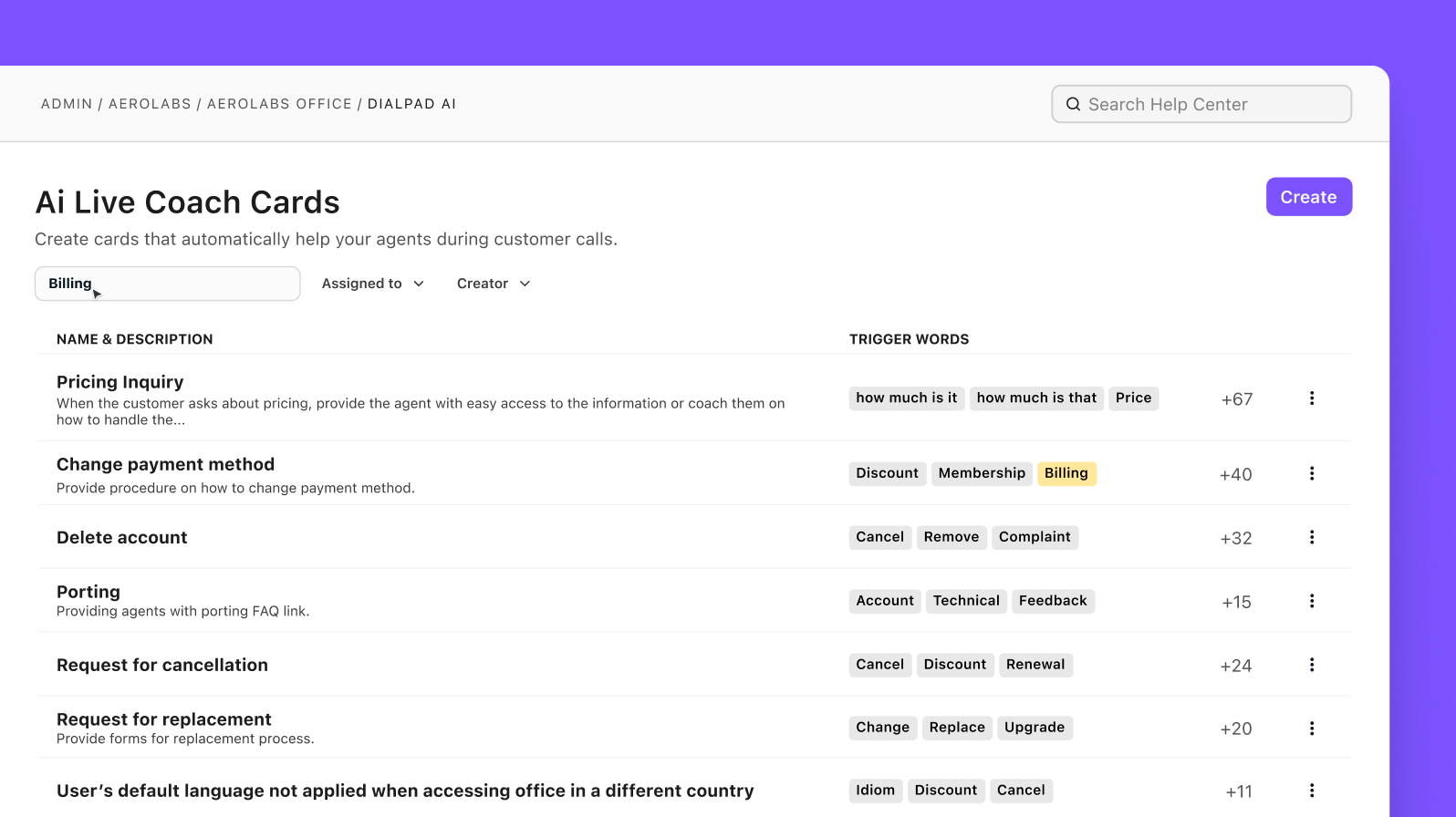
This is a great example of how artificial intelligence can help with coaching and training at scale—without requiring supervisors to personally help answer customer questions on every call with their agents.
🤖 Dialpad tip:
If your business sells a complex product or service, it takes a while for new agents to learn its ins and outs. But your contact center still has to provide world-class support at all times. And you can’t expect a brand new hire to get on a customer call and talk about the product like an expert. It’s a catch-22. This is where AI is very helpful for coaching in customer service!
Higher agent and customer satisfaction
Both agents and customers can benefit from AI technologies. For agents, AI can help them streamline their workflows and eliminate those repetitive everyday tasks.
AI might also help employees find the information they need much more quickly (especially when used together with a CRM like Salesforce), which leads to quicker resolutions for customers.
An example of how contact centers can use AI to help both agents and customers is live sentiment analysis. For example, Dialpad’s contact center platform can show a supervisor all the calls their agents are on—and the sentiment of each one:
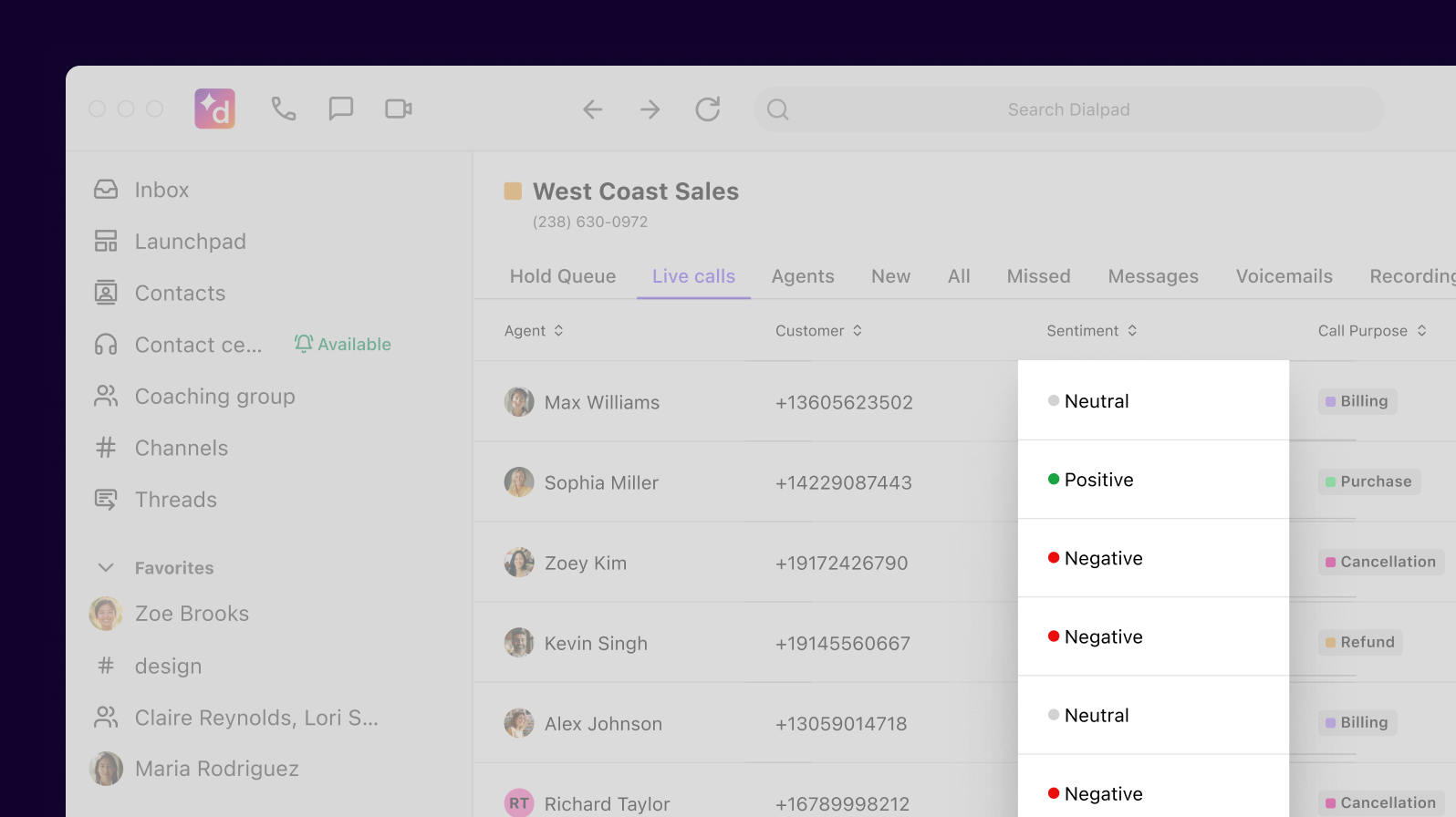
This allows supervisors to quickly scan ongoing calls to see if any agents need help and even read the transcripts (which get updated in real time) to get more context before deciding whether or not they need to jump on the call. Agents get timely help when they need it, and customers get faster resolutions to tricky problems because managers can be proactive about joining these conversations. A win-win for using AI.
5 examples of AI in customer service
The exciting thing about AI is that it has so many different implementation possibilities. Here are some common—and not-so-common—use cases for AI that I’ve seen.
1. Natural Language Processing (NLP)
NLP is a way of teaching computers to understand human language. We wrote extensively about it—and how we built this technology into Dialpad here!
The significance of NLP is huge for customer service. For instance, it’s the brains behind Dialpad AI, which as I mentioned earlier can transcribe calls—in real time—with extreme accuracy and also track certain keywords and how frequently they come up in customer conversations.
If you run a customer service team and want to see how often customers are asking for refunds and why, you can create a “Custom Moment” in Dialpad that’ll track every time “refunds” or “money back” is spoken on a call:
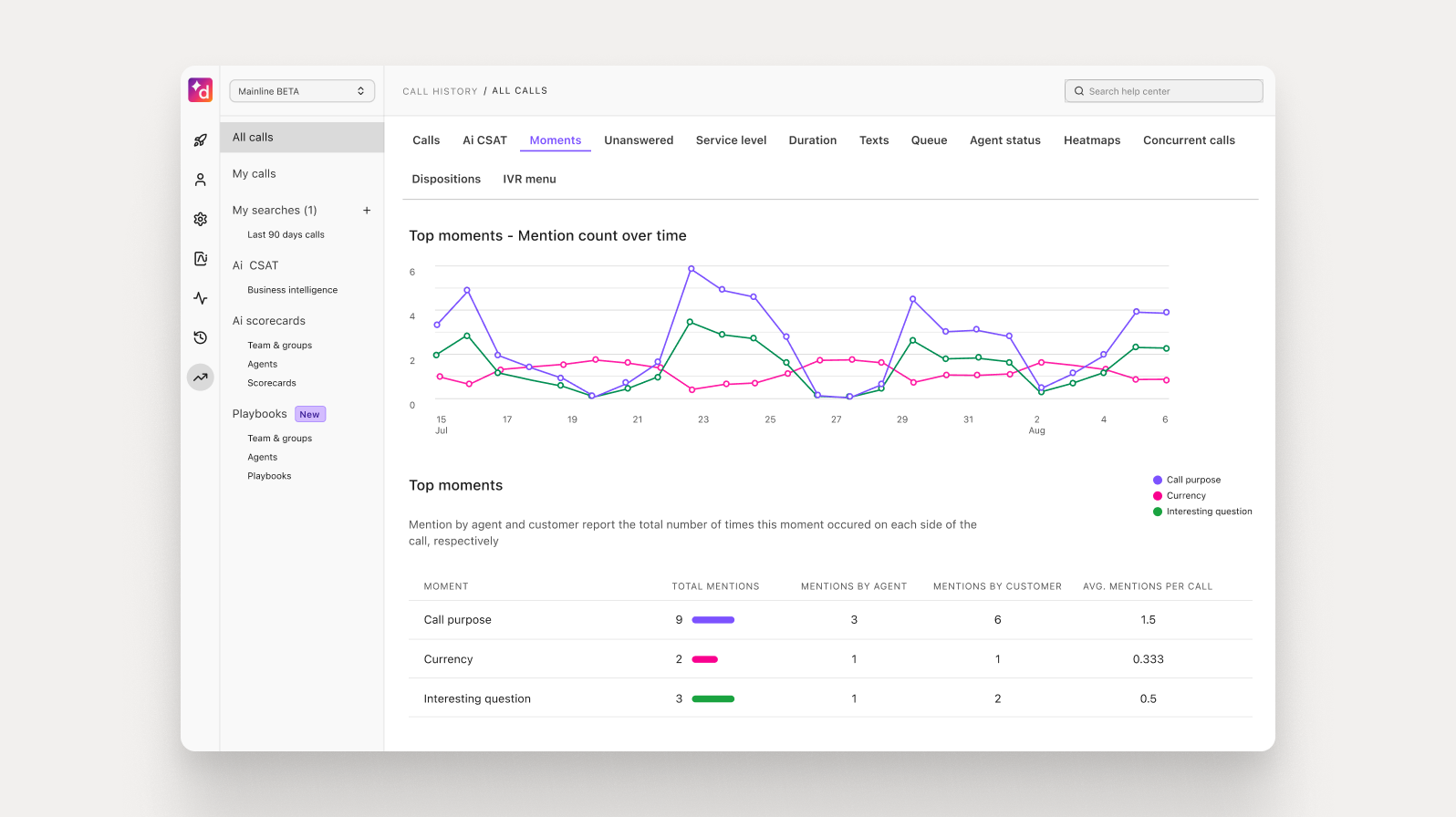
From there, you can see in Dialpad’s dashboard how frequently this shows up in calls over a period of time, then dig into the transcripts and recordings to get more context. With Dialpad AI helping you track these frequently recurring topics, you can use this data to create FAQ or knowledge base articles and improve training for your agents.
📚 Further reading:
Learn more about NLP in customer service.
2. Object detection
Object detection is a type of computer vision technique that locates individual objects within an image or video.
Neat, right? But what does it have to do with the digital customer experience?
Object detection software is a great way to improve your customers’ experiences as people are spending more and more time on mobile devices (and soon, likely VR and other technology).
Even now, its applications are quite widespread. For example, object detection can be used by ecommerce brands to aid image search functionality. With AI-powered software, an online shopper can easily take a snap of a product, and get presented with similar products available to buy.
3. Machine learning models
We hear about machine learning algorithms here, there, and everywhere these days. But what is its use case in customer service?
Firstly, machine learning is an application or subset of AI, and the idea behind machine learning is that computers should be able to “learn” and get smarter by taking in data. (NLP is specifically about interpreting language, so it’s not quite the same as machine learning. You might have some technology that uses both machine learning and NLP, for instance.)
4. Chatbots
If they're used well, chatbots can be very useful. What’s not to like about offering customers 24/7 instant answers to their basic requests, while qualifying inquiries by asking for customer info before passing a ticket onto a human customer agent?
The only thing to watch out for here is to make sure you have a solid chatbot platform. Historically, chatbots haven't been the best representation of an AI solution for customer service because of how rigid they can be.
For example, you’re interacting (I’d say talking, but you’re not really talking to it because it’s usually so rigid and scripted) with the chatbot—and then ultimately, it says “You have to call.”
Okay, we can accept that bots won’t be able to answer everything, but what you’re wondering now is “Well can you just transfer me?” and if it's not possible, then you've wasted this much time with the chatbot already and now you have to call the company and start over again.
Far from ideal. The other annoying thing, too, is when you do call, you’ll be on hold, and it’ll tell you, “Hey, did you know you can chat with us on our website?” And that was the first place you looked!
That’s precisely why I feel AI in customer service is best used to support and supplement processes to improve interactions—not try to replace them. It's also why we've designed the chatbot functionality in Dialpad Support to not only be able to search a wide range of data (including PDF documents and past customer calls), but also to be able to escalate the chatbot conversation to a human when they needed.
And you can create those flows easily just by dragging and dropping—no coding needed:
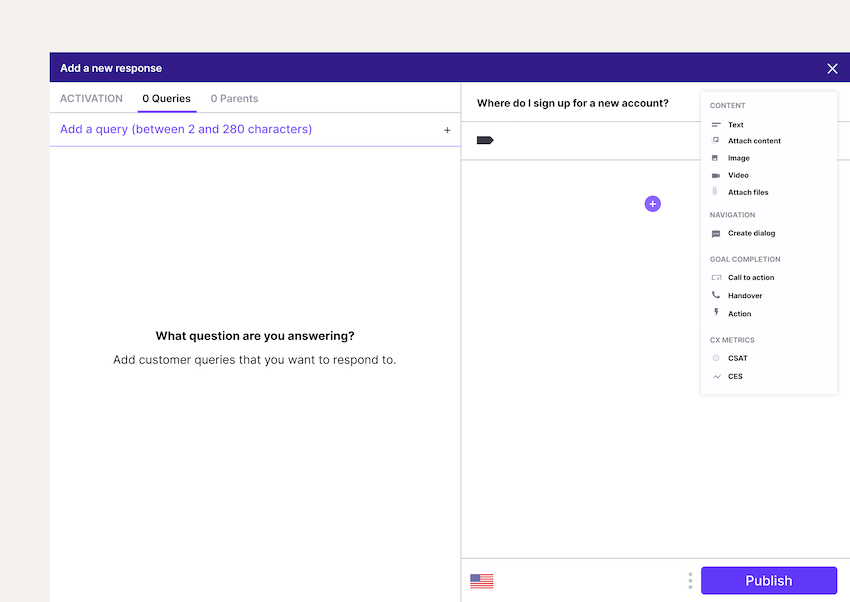
5. Agentic AI
If chatbots are designed to answer questions, agentic AI is designed to get things done. It represents the next major leap in AI for customer service, moving from conversation to autonomous action.
An AI agent can understand a user's goal, create a plan to achieve it, and then execute that plan by using various tools and systems on its own. Think of it less as a conversational partner and more as an autonomous digital employee. Once an AI agent understands a request, it can access an order management system, make updates to order details, or update a customer record autonomously. There are many use cases for agentic AI in customer service settings.
For customer service teams, agentic AI offers the ability to automate entire workflows, not just initial conversations. This frees up human agents to focus exclusively on complex, high-value, or sensitive customer issues that require true empathy and problem-solving skills. The key, as with any AI tool, is to ensure a seamless handoff to a human agent when needed, with the full context of every action the AI has already taken.
Agentic AI for the contact center
Dialpad’s agentic AI provides autonomous agent assistance that resolves customer needs in real time across voice and digital channels, managing routine tasks like scheduling and order updates while seamlessly transferring full context to a human agent when needed.
A few building blocks to help you successfully implement AI customer service solutions
Data unification
First thing’s first, you’ll need unified data. Unified data is essential for achieving a single customer view that encompasses your entire operation.
Data unification tools pull together multiple disparate data sources and turn that raw data into one centralized view of your operations.
Once your data is unified, you’ll be able to incorporate data sets collected by different teams, departments, or even companies, and process that data for improved organizational alignment.
Real-time insights delivery
Contact centers need to be able to generate actionable insights in real-time, across departments. An AI platform that unifies your data across workflows and helps you derive real-time insights from it is a tremendous asset.
(Learn more about different customer service techniques.)
👉 Did you know?
With Dialpad, you can easily get data on your customer journeys via its accessible contact center analytics dashboard. From heat maps showing your average speed of answer to live sentiment analysis for every call, everything you need is at your fingertips.
4 best practices for AI-powered customer service and support
1. Research should always be the first step
When it comes to AI in customer service, research is your most important step.
Think about these questions as a start, and use them to vet any potential platforms accordingly:
Which channels do your customers prefer to use for customer support? (For example, messaging, SMS, Facebook Messenger or other social media platforms, or phone calls?)
What are your customers’ principal pain points and how could AI customer service help answer them?
Where are the weaknesses in your current customer service provision? Do your agents struggle with certain types of customer queries or does your contact center as a whole suffer from high turnover? Why?
How much time do agents spend actually interacting with customers, and how much is used up by post-call activity?
Once you have those answers, you’ll have a better idea of the AI-powered customer service features that may be most important to you.
For instance, if you do have high staff turnover and find it’s because agents aren’t well coached or supported, then it’s safe to say that any AI customer service or customer support platform you consider has to have some kind of AI-powered coaching.
(With Dialpad, you’ll get post call automation, live coaching and sentiment analysis, real-time assistance designed for customer service agents, all in one platform.)
2. Build on your customer feedback
Your customers are your most valuable assets. Make sure that you’re regularly incorporating customer feedback into your contact center decision making. After all, customer feedback is a direct representation of the customer or user experience.
Do they want self-service options? Do they prefer to interact on certain channels over others?
One simple way to start collecting feedback is through a customer satisfaction survey. Your contact center CSAT score measures how satisfied your customers are with the service you’re providing.
We can create CSAT surveys to automatically play after a customer call in Dialpad, and even set them to automatically ask customers to elaborate on the score they gave us:
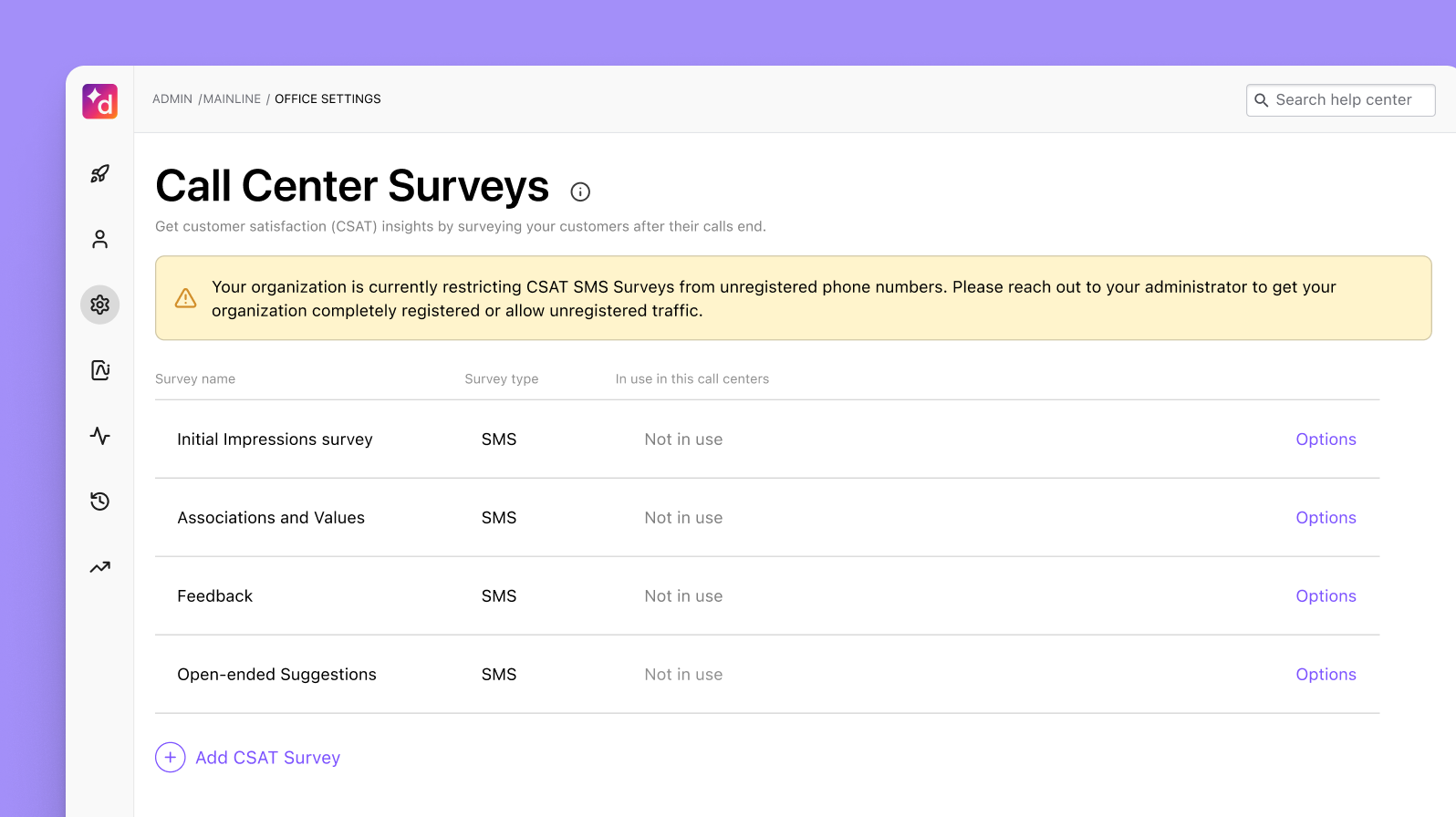
3. Personalize the experience across multiple channels
We’re in the personalization era. Personalization is like strong currency in the customer service world. Customers expect their conversations with us to be tailored automatically, and for us to understand customers’ needs without making them repeat themselves every time they talk to a different agent.
Just having real-time customer data isn’t enough—you have to be able to use it and make it accessible to everyone on your contact center team.
4. Consider having a monthly/quarterly/yearly performance analysis
Nothing ever stays the same for long. So make sure that you’re constantly reassessing your customer service processes.
The best way to do this is to schedule periodic performance analyses and reviews. You’ll be able to stay on top of what’s going well and what’s not, then make any necessary changes based on the data at hand.
This can include metrics like churn and customer retention rates (customer retention is a great measure of customer satisfaction). Consider looking at a before-and-after of these metrics: how did your team score before incorporating AI into your customer support, and how did you score after having used it for some time?
The future of AI in customer service is now
For some businesses, AI is the future of customer service. For others, it’s a future that has already started. Your customers expect a lot from their contact center experiences—personalized, real-time, flexible communications, and fast resolutions to their problems.
AI-powered customer communication can be a key asset in helping you achieve that.
Improve your customer retention and provide a better customer experience using AI
Book a demo to see how you can uncover real-time insights and provide real-time agent assists with Dialpad AI.
